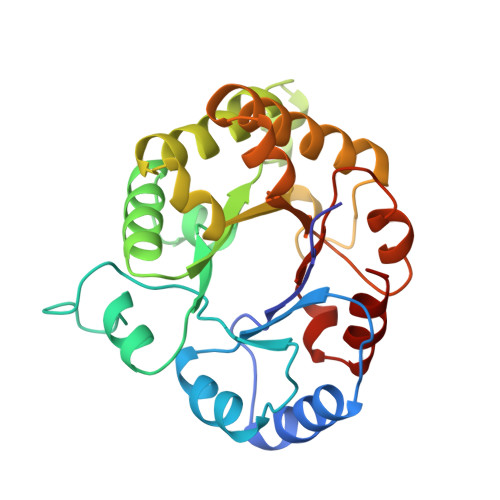Differences in the intersubunit contacts in triosephosphate isomerase from two closely related pathogenic trypanosomes.
Maldonado, E., Soriano-Garcia, M., Moreno, A., Cabrera, N., Garza-Ramos, G., de Gomez-Puyou, M., Gomez-Puyou, A., Perez-Montfort, R.(1998) J Mol Biol 283: 193-203
- PubMed: 9761683
- DOI: https://doi.org/10.1006/jmbi.1998.2094
- Primary Citation of Related Structures:
1TCD - PubMed Abstract:
The aligned amino acid sequences of TIM from Trypanosoma cruzi (TcTIM) and Trypanosoma brucei (TbTIM) have a positional identity of 68%. The two enzymes have markedly similar catalytic properties. Agents that interact with their interface Cys inhibit TcTIM and TbTIM; and those TIMs that lack this Cys (such as human TIM) are largely or completely insensitive to these agents. The susceptibility of TcTIM to the agents is approximately 100 times higher than that of TbTIM. To ascertain the cause of this large difference, the crystal structure of TcTIM was solved at 1.83 A resolution. The two enzymes are very similar homodimers. In TcTIM and TbTIM their respective Cys, 15 or 14, forms part of the dimer interface. In both, the contacts of the Cys with residues of the other subunit are almost identical. Nevertheless, there are noteworthy differences between the two; the existence of glutamine 18 in TbTIM instead of glutamic acid in TcTIM at the beginning of helix 1 decreases the contacts between this portion of the protein and helix 3 of the other subunit. In addition, TcTIM has proline at position 24 in the first helix of the TIM barrel; this is absent in the other TIM. Pro24 disrupts the regular helix arrangement, making the pitch of this helix 1.2 A longer than in TbTIM. When Pro24 of TcTIM was substituted for Glu, the sensitivity of TcTIM to sulfhydryl reagents increased about fivefold, possibly as a consequence of an increase in the space between the first portion of helix 1 and helix 3 of the other subunit. Therefore, it may be concluded that the geometry of the latter region is central in the accessibility to agents that perturb the interface Cys. In human TIM this region is more compact.
Organizational Affiliation:
Departamento de Genética Molecular, Instituto de Química, UniversidadNacional Autónoma de México 4510 México.














